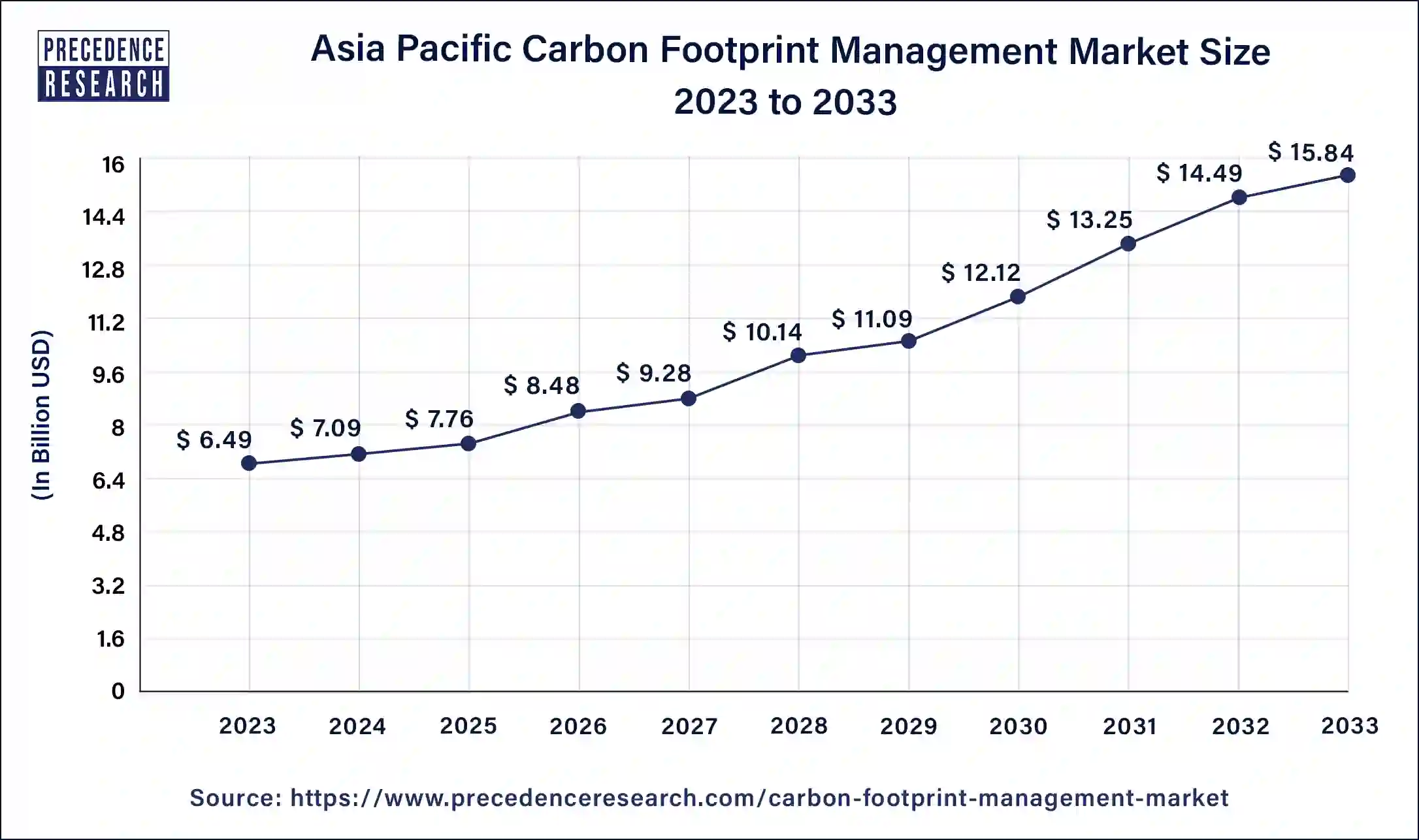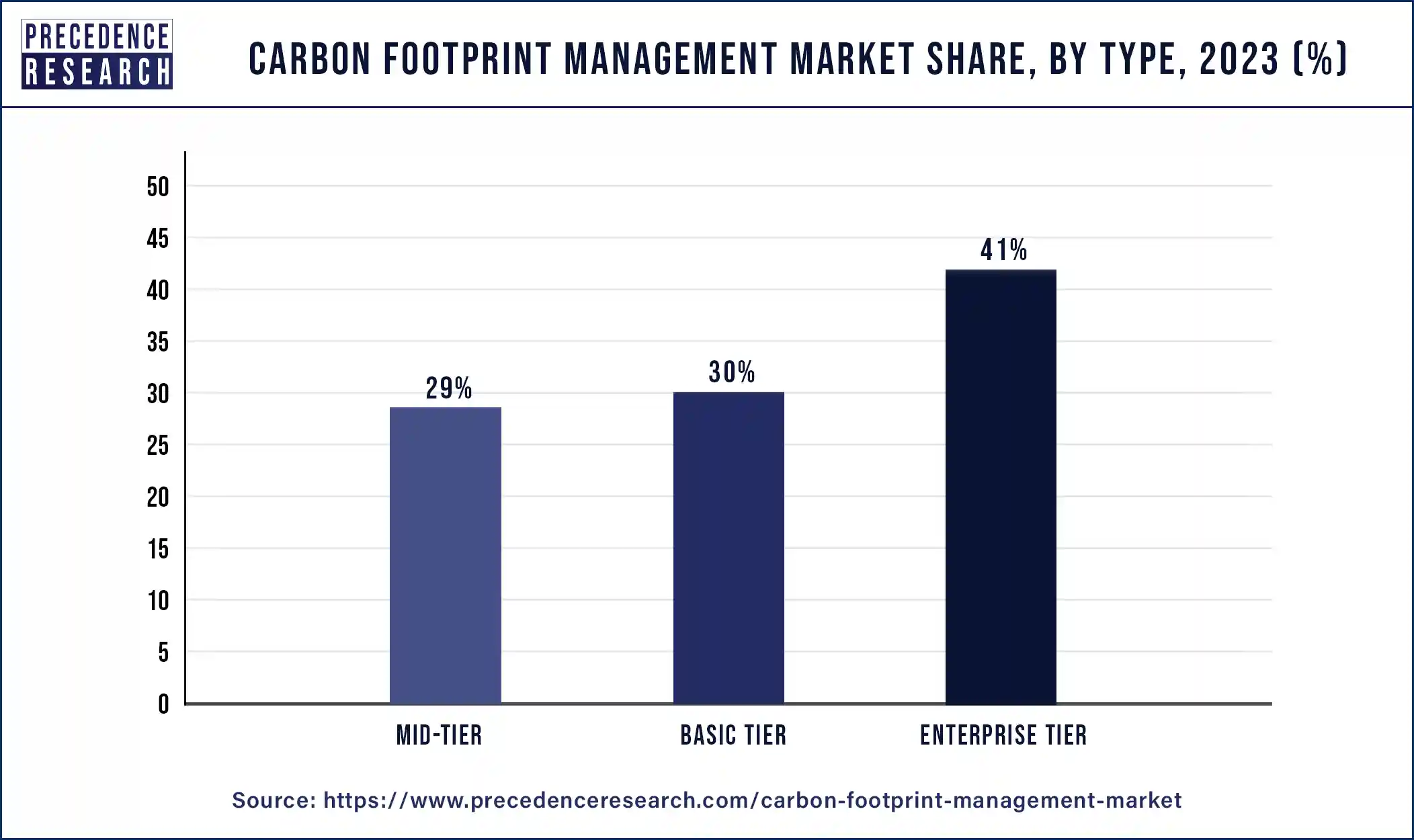November 2024
Carbon Footprint Management Market (By Deployment: On-Premise, Cloud; By Type: Basic Tier, Mid-Tier, Enterprise Tier; By End-Use: Energy and Utilities, Manufacturing, Transportation, IT and Telecommunication, Residential and Commercial Buildings) - Global Industry Analysis, Size, Share, Growth, Trends, Regional Outlook, and Forecast 2024-2033
The global carbon footprint management market size was valued at USD 11.19 billion in 2023 and is anticipated to reach around USD 27.08 billion by 2033, expanding at a CAGR of 9.24% from 2024 to 2033.

The Asia Pacific carbon footprint management market size was estimated at USD 6.49 billion in 2023 and is projected to surpass around USD 15.84 billion by 2033 at a CAGR of 9.33% from 2024 to 2033.

Asia Pacific dominated the carbon footprint management market in 2023 with new technology developments, strategies, and regulations. These things drive the region in the market. Asia Pacific is also a part of zero-carbon energy, and some Asia Pacific universities contribute to the reduction of greenhouse gas emissions. Although there is increasing development in urbanization and industrialization globally in the market, countries such as India and China. China is experiencing significant growth in the electric vehicle sector to boost energy efficiency, although some key players are investing in development, such as new energy infrastructure, electric vehicles, and batteries.

North American region is expected to grow in the carbon footprint management market during the forecast period due to climate change in countries such as Canada and the U.S. Increasing government support in the market and growing the adoption of carbon footprint management solutions drive the market growth. Also, regulations such as emissions reduction rules and affordable clean energy rules for management in various industries and North America adopt early emerging technology, including big data, AI, and blockchain, to improve automation, transparency, and data accuracy in carbon footprint management. These strategies are adopted by key players who are investing in management and supporting the market.
Europe is also experiencing significant growth in the carbon footprint management market, which is driven by the region's rapid adoption of advanced technologies to reduce carbon emissions. Some innovation is a key factor in Europe's expansion in the market. In Europe, industrial carbon management includes the use of technology to capture, transport, store, and use CO2 emissions.
Carbon Footprint Management Market Overview
The carbon footprint management market deals with providing solutions to reduce carbon footprint in different sectors. The market is experiencing frequent growth due to increasing global warming, global climate change, and weather anomalies, leading to the highest share of the market. These things are increasing day by day, and to manage these things, the adoption of carbon footprint management is also booming; the carbon footprint is the greenhouse gases that are released into the atmosphere and is an outcome of any human body activity; this increases climate change and global warming. In the carbon management market, government initiatives support addressing growing carbon emissions.
However, the adoption of advanced technology such as AI and IoT are integrated into the production methods, to enhance research & development including data collection, analysis reporting capabilities, and analysis. In the market, some key players are also investing in the industry, such as IBM, Dakota Software Corporation, IsoMetrix, and others that are leading the market growth.
| Report Coverage | Details |
| Growth Rate from 2024 to 2033 | CAGR of 9.24% |
| Global Market Size in 2023 | USD 11.19 Billion |
| Global Market Size in 2024 | USD 12.22 Billion |
| Global Market Size by 2033 | USD 27.08 Billion |
| Largest Market | Asia Pacific |
| Base Year | 2023 |
| Forecast Period | 2024 to 2033 |
| Segments Covered | By Deployment, By Type, and By End-Use |
| Regions Covered | North America, Europe, Asia-Pacific, Latin America, and Middle East & Africa |
Drivers
Need for carbon emission management in construction and housing
As more homes and businesses are built, they contribute to carbon emissions through various activities such as heating, cooking, waste management, and the use of refrigerants. To tackle this, carbon footprint management systems are becoming increasingly important. These systems help track, monitor, and reduce the emissions generated by these new establishments. This not only helps in combating climate change but also encourages the development of more sustainable construction practices. The increasing demand for housing and infrastructure is expected to positively impact the carbon footprint management market in the coming years.
Increasing economic worries and reducing carbon footprints
Rising economic worries and the push to reduce carbon footprints are key drivers for the growth of the market. As the economy faces challenges, there's a growing need for businesses and individuals to find ways to cut down on their carbon emissions. This is because high carbon emissions can lead to higher costs, such as higher energy bills, and can also have negative impacts on the environment.
So, companies and governments are looking for ways to manage and reduce their carbon footprints more effectively. This includes using cleaner energy sources, improving energy efficiency, and investing in carbon offset projects. As an outcome, the market for carbon footprint management is growing, driven by these economic pressures and to reduce carbon emissions.
Rising industrialization
The growing trend of industrialization is a significant driver for the expansion of the carbon footprint management market. More factories and industries are being built and operated, which contributes to carbon emissions. This is because industries often rely on fossil fuels for energy, which release carbon dioxide and other greenhouse gases into the atmosphere.
To address this, there's a growing need for systems that can help industries manage and reduce their carbon footprints. This includes tracking energy use, identifying ways to use less energy, and possibly even offsetting emissions through carbon offset projects. The increasing demand for sustainable practices in industries is expected to boost the market as companies look for ways to reduce their environmental impact.
Restraint
Variable energy and resource demand management
Variable energy and resource demand management can be a restraint for the carbon footprint management market. The energy demand can fluctuate a lot, especially with renewable sources such as wind and solar, which depend on weather conditions, which means companies need to constantly adjust their energy usage and management strategies, which can be complex and costly. For smaller businesses, this can be a real barrier to adopting more sustainable practices, as it requires significant investment in infrastructure and technology. This complexity can slow down the adoption of carbon footprint management systems and make it harder for businesses to effectively reduce their carbon emissions.
Opportunity
Increasing adoption of green initiatives
The shift towards green initiatives is a big opportunity for the carbon footprint management market. As a growing trend towards being more environmentally friendly, more people and businesses are starting to care about the environment and are looking for ways to reduce their carbon footprints. This means there's a growing demand for tools and services that can help them measure, track, and reduce their carbon emissions.
The market is expected to grow as a result, driven by this increasing interest in sustainability. This growth is supported by increasing energy demand by industries, the adoption of targets to control global warming, and an increase in government initiatives to reduce carbon emissions. So, the market for carbon footprint management is not just growing, but it's also becoming more important as the world moves towards more sustainable practices.
The cloud segment dominated the carbon footprint management market in 2023, and demand for cloud-based carbon footprint management is continuously growing. This cloud-based carbon management system allows remote access and enables users to manage and track emissions data from anywhere. Organizations often find cloud deployment more cost-efficient and eliminate the need for on-premises infrastructure, reducing maintenance costs. A cloud-based system utilizes artificial intelligence (AI) to analyze data, identify patterns, and develop reduction strategies. However, some cloud providers have invested in robust data security measures to protect sensitive carbon emissions data.

The on-premise segment is also growing in the carbon footprint management market due to some reasons on-premises are increasing, such as the level of control offered. Organizations can customize their systems and software to meet specific requirements, as they have full control over their infrastructure. In specific scenarios, on-premises systems can outperform cloud applications due to their on-site infrastructure; for industries requiring strict safety and observation regulations, on-premises computing is a favorable option. This is crucial for organizations that need to maintain sensitive data or operate in highly restrained sectors, and these benefits on-premises are growing in the market.
The enterprise-tier segment dominated the carbon footprint management market in 2023. An enterprise-tier system is a comprehensive software solution for big organizations with complex operations, stringent reporting needs, and extensive emissions profiles. Enterprise-level systems provide advanced features to measure, track, and manage sustainable data and carbon emissions. The growing awareness of CO2 reduction in many industries has increased demand for enterprise-level solutions.

The mid-tier segment also plays a significant role in the market. The mid-tier carbon footprint management system is a software solution that can track, manage, measure, and provide comprehensive features for managing sustainability and emissions data. With less geographical presence and emissions capability, medium-scale organizations typically adopt mid-tier carbon footprint management software.
The energy and utilities segment dominated the carbon footprint management market in 2023. This is because energy and utilities are major sources of carbon emissions, and they play a crucial role in reducing these emissions. By adopting cleaner and more efficient energy sources, such as renewable energy, and implementing carbon offset programs, energy and utility companies can significantly reduce their carbon footprint. This not only helps in combating climate change but also opens up new opportunities for these companies to innovate and improve their services. The market for carbon footprint management is growing, driven by increasing awareness about climate change and the need for sustainable energy.
The manufacturing segment is expected to grow in the carbon footprint management market during the forecast period because manufacturing industries are often the biggest sources of carbon emissions. Many companies in this sector are realizing the importance of reducing their carbon footprint, not just for the environment but also to avoid potential risks such as damage to their reputation and regulatory risk. Companies are looking for ways to make their manufacturing processes more sustainable, which is where carbon footprint management comes in. Adopting low-carbon practices and using software to track and reduce carbon emissions increases the demand for carbon footprint management in the market. Also, manufacturing companies can protect their businesses from potential legal and reputational issues.
Segments Covered in the Report
By Deployment
By Type
By End-Use
By Geography
For inquiries regarding discounts, bulk purchases, or customization requests, please contact us at sales@precedenceresearch.com
No cookie-cutter, only authentic analysis – take the 1st step to become a Precedence Research client
November 2024
February 2025
August 2024
April 2025